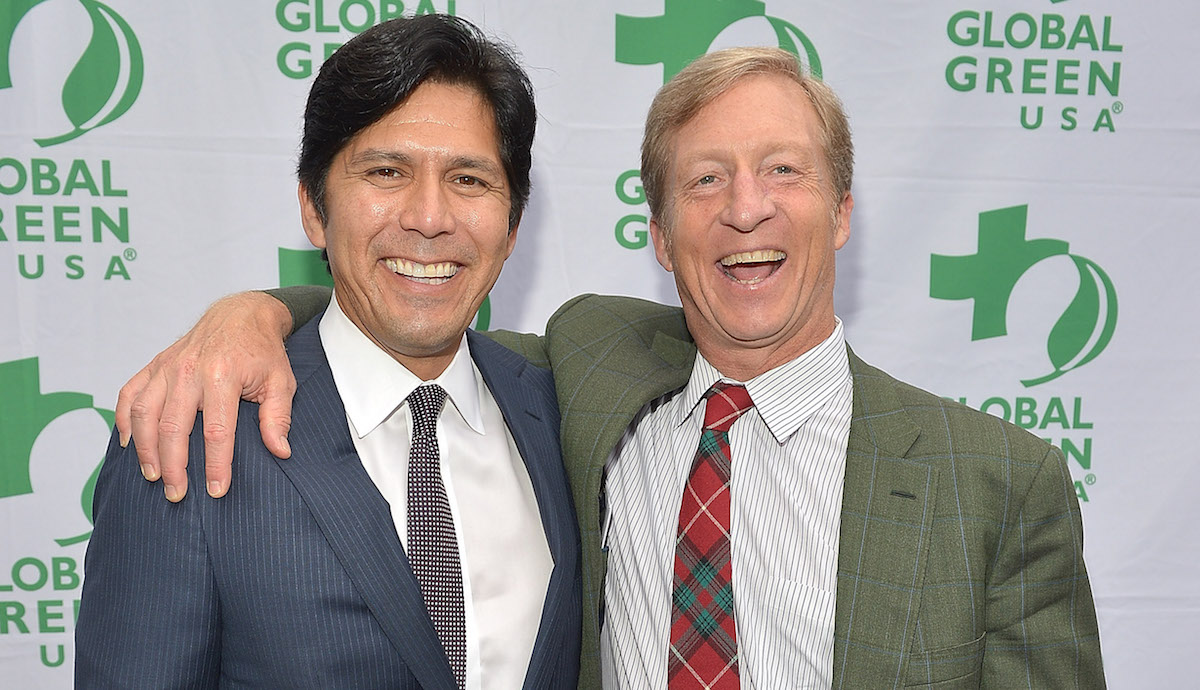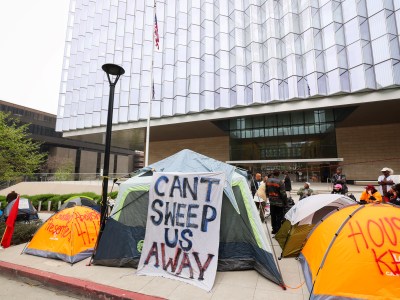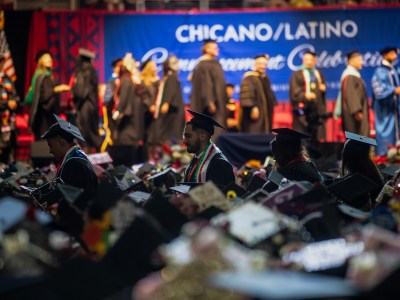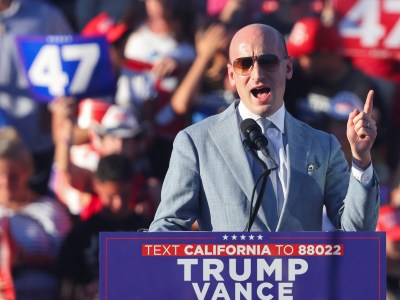In summary
The friendship between two men from vastly different backgrounds may shape the future of California.
One of them grew up in the barrio of San Diego, the son of an immigrant maid who struggled to pay the rent. The other was raised in one of the nation’s most exclusive zip codes, the youngest son of a New York City lawyer.
Their lives diverged for decades. The boy who spent his childhood along the Mexican border dropped out of college and went to work advocating for immigrants and teacher unions. The kid from New York’s Upper East Side graduated from Yale and Stanford, and then started an investment firm in San Francisco.
Today, one is among California’s most powerful politicians, the other is a billionaire. And they have built a friendship that may shape the future of the state.
Kevin de León, leader of the California Senate, and Tom Steyer, a former hedge fund manager, have joined forces around their shared desire to fight global warming. After working together to pass an energy-efficiency ballot measure in 2012, they are teaming up this year to push for legislation that would reduce California’s greenhouse gas emissions and shift the economy away from oil and gas.
Both men are lifelong Democrats, but came to environmentalism later in life and from different starting points – de León, 48, from a focus on justice, Steyer, 58, from a belief in God.
“We share the same goals together,” said de León, D-Los Angeles. “And we continue to be supportive of each other because this is an issue we care deeply about.”
Steyer, a major donor to Democrats nationwide, is pouring money into the California Capitol, and de León is introducing bills that echo Steyer’s environmental agenda. This kind of coalescence is common in American politics, where campaign spending gives some advocates an outsized voice, said Jessica Levinson, a professor at Loyola Law School who sits on the Los Angeles Ethics Commission.
“This is the story of politicians and their benefactors,” she said. “It doesn’t mean that it’s nefarious… This is just the way it is. You get meetings and people pay attention because you can write checks that have a lot of zeros.”
Steyer has spent more than $39 million on California political campaigns in the last 15 years, the bulk of it on two climate-change related ballot measures. In the last year, however, his spending reveals a greater focus on who gets elected to the statehouse. In 2014, Steyer gave $1.3 million to Democrats’ legislative campaign efforts and gave the maximum allowable donation to Gov. Jerry Brown’s re-election campaign. An ally of organized labor, he donated $150,000 this year to a union-backed committee that tried unsuccessfully to sway a state Senate race.
Last year, Steyer’s nonprofit advocacy group, Next Gen Climate Action, registered to lobby in California. The group has run ads supporting de León’s Senate Bill 350, which calls on the state to cut petroleum use in half, increase the use of wind and solar power to create electricity, and boost energy efficiency in buildings. Steyer himself is lobbying for the legislation, too, both in public testimony and in private meetings with lawmakers.
He’s also working on other bodies of power. In June, he urged the state teachers’ retirement fund to consider shifting investments away from fossil fuels, and toward clean sources of power. A similar idea is housed in de León’s SB 185, which would require the state’s public retirement systems to divest from coal.
“I have talked to Kevin over the years about a bunch of things, but I think he deserves all the credit for coming up with those specific bills,” said Steyer. “We’ve talked about all the topics, but those are really his.”
While Steyer’s spending is princely, it is dwarfed by the money his political enemies in the oil industry pour into California politics. The industry’s main advocacy group in Sacramento spent $8.9 million lobbying last year – far more than any other group. And a half-dozen leading oil companies last year poured $13.8 million into political campaigns in the state.
The relationship between de León and Steyer began in 2011 when Steyer spoke to a Senate Democrats policy meeting in Sacramento. They exchanged cards, de León said, and “hit it off because we had the same goals: economic growth, job creation, and cleaning up our environment.”
Those were major themes in their joint campaign for Proposition 39 in 2012, which Steyer funded with $30 million. The measure made a change to California’s corporate tax formula that de León had been unable to get through the Legislature, and devoted the new money to energy efficiency upgrades in public schools.
De León, who finished college at age 36, said he had little interest in climate change early in his political career. He came to the issue after realizing that poor people suffer from “inequities in the environmental space.” His first bill as a legislator allocated bond money to build parks in underserved neighborhoods. Three years ago, de León carried a bill that requires spending 25 percent of the money generated by California’s cap and trade auctions to benefit disadvantaged communities.
This year, in appearances around the state, de León is working to make an issue usually associated with elite coastal communities relevant in working-class and Latino neighborhoods. At an event highlighting state funding for rooftop solar panels, he talked with Spanish-language media about the health benefits of drawing electricity from “el poder del sol.” And in a speech to Latino community organizers, he said his clean energy proposal would create “real jobs for our community.”
A defining moment in de León’s political evolution came in 1994, when he helped organize a massive Los Angeles protest against Proposition 187. The measure – ultimately ruled unconstitutional – blocked undocumented immigrants from public services, including health care and education. De León and his then-girlfriend marched with their baby daughter in a stroller.
Steyer, at that time, was running Farallon Capital Management in San Francisco. He and his wife had three children and another one on the way. Steyer says he opposed the anti-immigration ballot measure, but the focus of his attention then was on his business. Over time, he said, his concern about climate change grew with his Christian faith.
“I became more religious, and so I started to look at the world from the point of view of, ‘What are we doing in terms of stewarding creation for everyone in the world and for all living creatures?’” said Steyer, who routinely inks the sign of the cross on his hand with a ballpoint pen and has signed a pledge to donate more than half his wealth to charity.
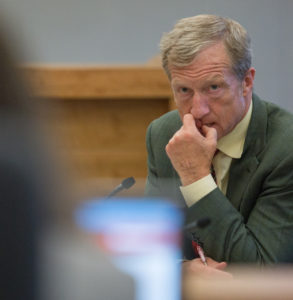
The relationship between de León and Steyer is both professional and personal, said former Assembly Speaker Fabian Núñez, a lifelong friend of de León’s who carried California’s landmark climate change bill in 2006. But Steyer’s influence on his friend is minimal, Núñez said.
“There’s no question in my mind that Kevin would continue to pursue all of the various efforts around improving the environment and climate change,” even without Steyer’s advocacy, Núñez said.
“No question.”
Steyer’s political combatants in the oil industry see the relationship differently. They say de León’s policies will benefit Steyer financially because of his investments in clean energy companies.
“It is a concern that a hedge fund billionaire who made his fortune off fossil fuels is now promoting policies that he can profit from,” said Sabrina Lockhart, spokeswoman for an industry coalition called Californians for Energy Independence.
The group formed to oppose Steyer’s effort to levy a tax on oil extraction. Steyer laughed at his opponents’ argument, saying if he was out to make money he would have stayed at the hedge fund he quit to devote himself to climate activism. Besides, Steyer said, in anticipation of such criticism, he set up all his clean energy investments so that the profit can only go to charity.
“It can never go back to me or my family,” he said.
In recent years Steyer and de León have appeared together at various environmental and political events, where, Steyer says, they enjoy cracking jokes and talking sports. De León has been a guest at the San Francisco home where Steyer and his wife Kathryn Taylor have hosted President Barack Obama and presidential candidate Hillary Clinton.
“When we go back home today in 2015, we go back home to two very different lives and two very different houses,” said de León, who never married or bought a home.
Where de León readily acknowledges differences between the friends, Steyer focuses on what they have in common.
“I don’t see this in any way as a strange friendship,” he said. “Kevin knows some stuff that I don’t know, which I’m very happy to understand. I know some stuff Kevin doesn’t know. And so I don’t view it as two different people; I think of it as two people who are worried about the same things, care about the same things, and are willing to work hard.”
Which is exactly what they’re doing now.


